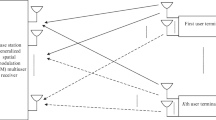Abstract
In this paper, the complexity and performance of the Auxiliary Vector (AV) based reduced-rank filtering are addressed. The AV filters presented in the previous papers have the general form of the sum of the signature vector of the desired signal and a set of weighted AVs, which can be classified as three categories according to the orthogonality of their AVs and the optimality of the weight coefficients of the AVs. The AV filter with orthogonal AVs and optimal weight coefficients has the best performance, but requires considerable computational complexity and suffers from the numerical unstable operation. In order to reduce its computational load while keeping the superior performance, several low complexity algorithms are proposed to efficiently calculate the AVs and their weight coefficients. The diagonal loading technique is also introduced to solve the numerical unstability problem without complexity increase. The performance of the three types of AV filters is also compared through their application to Direct Sequence Code Division Multiple Access (DS-CDMA) systems for interference suppression.
Similar content being viewed by others
References
D. Tufts, I. Kirsteins, R. Kumaresan, Data adaptive detection of a weak signal, IEEE Trans. on Aerospace and Electronic Systems, 19(1983)2, 313–316.
J. Goldstein, I. Reed, Reduced rank adaptive filtering, IEEE Trans. on Signal Processing, 45(1997)2, 492–496.
B. Xu, C. Yang, S. Mao, On subspace selection criterions for reduced-rank adaptive filtering, submitted to IEEE Signal Processing Letters.
J. S. Goldstein, I. S. Reed, L. L. Scharf, A multistage representation of the Wiener filter based on orthogonal projections, IEEE Trans. on Information Theory, 44(1998)7, 2943–2959.
D. A. Pados, S. N. Batalama, Joint space-time auxiliary-vector filtering for DS/CDMA systems with antenna arrays, IEEE Trans. on Communications, 47(1999)9, 1406–1415.
D. A. Pados, G. N. Karystinos, An iterative algorithm for the computation of the MVDR filter, IEEE Trans. on Signal Processing, 49(2001)2, 290–300.
D. A. Pados, F. J. Lombardo, S. N. Batalama, Auxiliary-vector filters and adaptive steering for DS/CDMA single-user detection, IEEE Trans. on Vehicle Tech., 48(1999)6, 1831–1839.
W. Chen, U. Mitra, P. Schniter, On the equivalence of three reduced rank linear estimators with applications to DS-CDMA, IEEE Trans. on Information Theory, 48(2002)9, 2609–2614.
I. N. Psaromiligkos, S. N. Batalama, Interference-plus-noise covariance matrix estimation for adaptive space-time processing of DS/CDMA signals, in Proc. IEEE Int. Conf. Vehicular Technology (VTC2000 fall), Boston, MA USA, Sept. 24–28, 2000, 2197–2204.
M. T. Heath, Scientific Computing: An Introductory Survey, 2nd ed., McFraw-Hill, New York, 2002, Chapter 2.
Author information
Authors and Affiliations
Additional information
Communication author: Xu Bin, born in 1974, male, Ph.D. Lixi 205, National Mobile Communications Research Laboratory, Dept of Radio Engineering, Southeast University, Nanjing 210096, China.
About this article
Cite this article
Xu, B., Yang, C. & Mao, S. Study on efficient computation and performance of AV-based reduced-rank filtering. J. of Electron.(China) 22, 153–160 (2005). https://doi.org/10.1007/BF02688142
Received:
Revised:
Issue Date:
DOI: https://doi.org/10.1007/BF02688142




